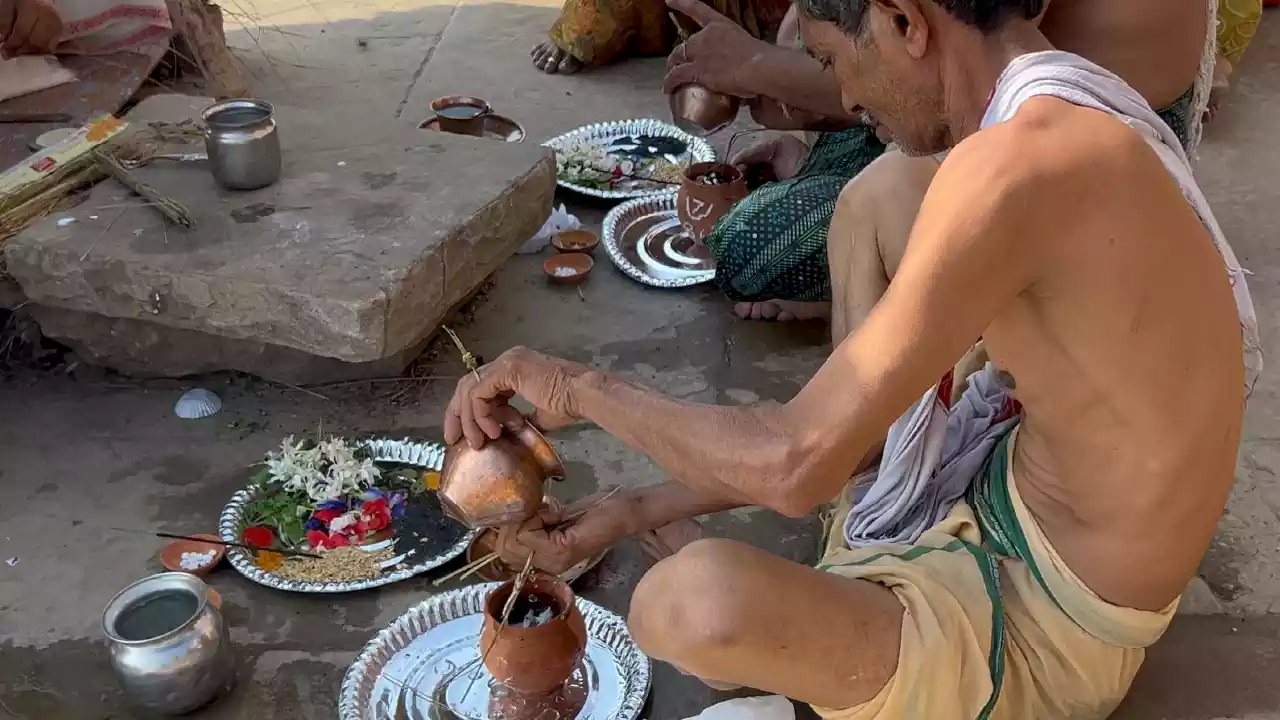A question often arises in the hearts of those who live far from the sacred soil of Bharat, yet whose souls are tied to this land by the invisible threads of ancestry. You feel the pull, the duty, the deep love for those who came before you, and you wonder, “When should I make the journey? When is the best time for Teerth Shradh to offer my respects and seek blessings?”
It is a profound question. In our Sanatana Dharma, time is not merely a clock ticking away; it is a living, breathing entity. It is a cosmic cycle of auspicious and challenging moments. Performing a ritual at the right time, or muhurta, is like planting a seed in the most fertile soil during the perfect season. The results are magnified, the connection is deeper, and the blessings flow abundantly. The satisfaction received by our Pitrus, our ancestors, is immense.
Let us explore these sacred windows of opportunity, as taught to us by the sages and recorded in our holy Puranas.
Why Timing is Everything in Ancestral Rites
You may think that any day you remember your ancestors with love is a good day. And you are right; love is never wasted. However, certain cosmic alignments create powerful gateways, moments when the veil between our world and the realm of the Pitrus is thin. During these times, our offerings, our prayers, and our reverence reach them most effectively.
Think of it like this: you can call out to a friend across a noisy marketplace anytime, and they might hear you. But if you wait for a moment of quiet, your voice will carry clearly, and your message will be received without distortion. The Puranas guide us to these moments of cosmic quiet and clarity, ensuring our offerings of Shradh are received with the greatest impact.
The Pinnacle: Pitru Paksha (The Fortnight of the Ancestors)

If there is one period that stands above all others for performing Teerth Shradh, it is the sacred fortnight known as Pitru Paksha. This is, without a doubt, the single best time for Teerth Shradh.
When is Pitru Paksha?
This hallowed period falls during the dark half (Krishna Paksha) of the lunar month of Bhadrapada, which usually corresponds to September or early October in the Western calendar. The cosmos aligns in a special way during these 15 days. The Brahma Purana teaches us that when the Sun enters the zodiac sign of Kanya (Virgo), this time becomes exclusively dedicated to the ancestors. The day when the Sun is in Virgo and the moon is in the Hasta nakshatra is known as Mahalaya, a day of immense significance.
Why is this Period So Special?
Our scriptures, like the Skanda Purana, tell us a beautiful and poignant truth: during Pitru Paksha, our ancestors are permitted to leave their abode and come closer to the earthly realm, to be near their descendants. They travel to the doorsteps of their children and grandchildren, eagerly waiting, hoping to receive offerings of water (Tarpan) and food (Pinda Daan).
They wait with anticipation, much like parents waiting for their child to return home for a festival. When we perform Shradh during this time, we are directly feeding their essence, quenching their spiritual thirst, and bringing them profound peace and satisfaction. If this period passes without any offerings, they are said to return to their realm disheartened. Therefore, performing Shradh at a sacred Teertha like Prayag, Gaya, or Kashi during Pitru Paksha brings immeasurable merit.
Beyond Pitru Paksha: Other Powerful Windows for Shradh

While Pitru Paksha is the supreme period, our compassionate tradition provides many other auspicious times for those who cannot make the journey during that specific fortnight.
The Monthly Anchor: Amavasya (The New Moon)
Every month, the day of the new moon, or Amavasya, is a powerful day for connecting with the ancestors. The waning period of the moon is generally considered suitable for Shradh, with Amavasya being the peak. It is a recurring monthly opportunity to renew your connection and offer your respects.
Cosmic Alignments: Eclipses and Yogas
Certain astronomical events create incredibly potent moments for spiritual practices.
-
Eclipses (Grahan): Both solar (Surya Grahan) and lunar (Chandra Grahan) eclipses are considered exceptionally powerful times for any spiritual act, including Shradh. Any bath, charity, or ritual performed during an eclipse yields undiminishing benefits.
-
Special Yogas: There are specific celestial conjunctions, known in astrology as Vyatipata and Vaidhriti, which are also highly recommended for ancestral rites. These are technical, but a learned Pandit can easily identify these days for you.
The Sun’s Sacred Journey: Sankranti and Ayanas
The Sun is the source of all life, and its journey through the zodiac holds great significance.
-
Sankranti: The day the Sun moves from one zodiac sign to another is called Sankranti. The Shiva Purana states that performing Shradh on a Sankranti day yields ten times more benefit than on ordinary holy days.
-
Solstices (Ayanas) & Equinoxes (Vishuva): The two solstices—when the Sun begins its northern journey (Uttarayan, around January) and its southern journey (Dakshinayan, around July)—are pivotal points in the year. Along with the equinoxes in spring and autumn, these are prescribed as highly meritorious times for Shradh and charity.
A Seasonal Guide for Your Journey from Abroad
For people living in Malaysia, Singapore, and Sri Lanka, practical considerations like weather are also important when planning a pilgrimage. Our sacred texts, while focusing on cosmic time, also acknowledge the earthly seasons.
Autumn and Early Winter (October – February): The Pleasant Passage

This period, which includes the holy months of Karttika and Magha, is often the most comfortable for travel in Northern India.
-
Karttika (October-November): The climate is pleasant and mild. The scriptures praise Karttika as a most excellent month. The holy baths and charitable acts performed during this time are deeply connected to the benefits of Shradh.
-
Magha (January-February): This is the heart of winter. While it can be chilly, especially in the mornings, the weather is generally dry and clear. The full moon day of Magha is incredibly sacred, especially in Prayag. It is a wonderful time for a holy dip and performing your duties to the Pitrus.
Late Winter and Spring (February – April): A Time of Renewal
This is another excellent window for travel. The weather transitions from cool to warm, making it very comfortable to perform rituals at the ghats and visit temples.
Summer and Monsoon (May – September): A Time for Caution
-
Summer (Grishma): From late April to June, the heat in places like Prayag and Kashi can be intense. While the rituals are just as effective, the physical exertion can be challenging for those not accustomed to it.
-
Monsoon (Varsha): From July to early September, the rains arrive. While the Garuda Purana mentions that Shradh performed with the proper hymns during the rainy season brings great delight to the manes, travel can be disrupted, and the high humidity can be uncomfortable.
The Power of Tithi: Choosing a Specific Lunar Day for Specific Blessings
Beyond the month or season, the specific lunar day, or Tithi, on which you perform Shradh can bestow particular blessings upon your family. The Mārkaṇḍeya Purana and Brahma Purana give us this beautiful guide:
| Lunar Day (Tithi) | Blessings You Can Pray For |
| First (Pratipat) | For Blessings of Wealth and Prosperity |
| Second (Dvitiya) | For Good Progeny or a Virtuous Spouse |
| Third (Tritiya) | For the Blessing of Sons |
| Fourth (Chaturthi) | For Overcoming Obstacles and Enemies |
| Fifth (Panchami) | For Acquiring Assets and Good Children |
| Sixth (Shashthi) | For Overall Well-being and Honour |
| Seventh (Saptami) | For Leadership and Success in Ventures |
| Eighth (Ashtami) | For Gaining Intelligence and Wisdom |
| Thirteenth (Trayodashi) | For Growth in Family, Longevity, and Intellect |
A Final Word of Guidance
Remember this: the best time for Teerth Shradh is when you can come with a heart full of devotion, respect, and sincerity.
To summarise for your planning:
-
The Absolute Best: Pitru Paksha (usually September/October) is unparalleled.
-
Excellent Alternatives: The months of Karttika (Oct-Nov) and Magha (Jan-Feb) offer a perfect blend of auspicious time and comfortable weather for travel.
-
Good Opportunities: Any Amavasya (new moon day), Sankranti, or eclipse is highly meritorious.
Do not be discouraged if your circumstances do not allow for the “perfect” time. The Pitrus understand the limitations of their children. Any act of remembrance, any prayer offered with a pure heart at a holy Teertha, will surely reach them. Your effort to connect with your roots is, in itself, a great blessing to them and to you.
May your path be clear, and may the blessings of your ancestors illuminate your life always.
Hari Om Tat Sat.
